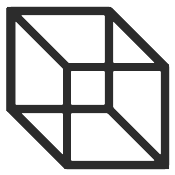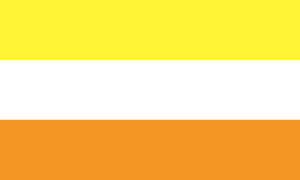Glossary of English gender and sex terminology
| |
This glossary of English gender and sex terminology shows actual language use. Unless a word is marked with a specific country, assume all these words may be used internationally, in any country where English is spoken.
This could be called a MOGII glossary. This glossary's selection of words has a focus on nonbinary identities, and closely related subjects of gender non-conformity. This glossary also collects words about gender and sexuality, especially words used by or in reference to MOGII identities (transgender, gay, lesbian, bisexual, and asexual), as well as intersex conditions, as these provide essential context, and often have an overlap with the main subject. The glossary includes psychiatric terminology as well as subcultural slang, and obsolete historical terms as well as very new words (neologisms). The words cover identity labels, gender-neutral pronouns, diagnoses, and political issues.
If you put more words into this glossary, try to only put in words that you wouldn't find in the average pocket dictionary. Give sources to show that the word is really used in the way you say, or, if the wiki has an entry about that word, link to it. Keep glossary entries short, about three lines long at most. If they get too long, make a new wiki article for them.
Although it is useful to learn how to understand specialized jargon, you can be more helpful to your readers if you keep your own writing easy to understand. When writing for this wiki, please try to use plain English as much as possible, and use specialized jargon only sparingly, and as needed.
A
- ace. Short for asexual, which see.[1]
- AGAB. Assigned gender at birth. Most people are either assigned female at birth (AFAB) or assigned male at birth (AMAB).
- AFAB. See AGAB.
- agender. A nonbinary identity. 1. Some who call themselves agender have no gender identity (genderless). 2. Some who call themselves agender have a gender identity, which isn't female or male, but neutral.
- AMAB. See AGAB.
- ambonec. A nonbinary "gender identity in which you identify as both male and female, yet you also identify as neither, at the same time."[4][5][6]
- androgyne. This word is used for a wide variety of gender nonconforming and non-binary gender identities and gender expressions.
- androphilic. A romantic and sexual orientation in which a person feels attraction to men or masculinity.[7]
- aporagender. Coined in 2014, from Greek apo, apor "separate" + "gender".[8] A nonbinary gender identity and umbrella term[9] for "a gender separate from male, female, and anything in between while still having a very strong and specific gendered feeling" (that is, not an absence of gender).[10]
- aromantic. A romantic orientation in which a person doesn't feel romantic attraction to people of any gender.[11]
- asexuality. A romantic and sexual orientation in which a person doesn't feel attraction.
B
- berdache. An old word used by European-American people and anthropologists for gender roles in Native American cultures that are now called two-spirit.
- bi. Short for bisexual, which see.
- bi-gender, bigender. Bigender individuals have two gender identities, at the same time, or at different times.[12]
- binarism. Discrimination against ethnic groups and cultures that recognize non-binary genders, based on the sexist belief that there are only two genders (nonbinary erasure).
- binary gender. A gender identity that fits neatly into only one of the two genders in a gender binary system.
- binder. An undergarment that a person can wear to make their chest look flat. Transgender men wear these so they have a male body shape, if they haven't had surgery to that effect. Some non-binary people wear these to flatten breast tissue.
- biological boy. A less correct term for an AMAB person, which see.
- biological girl. A less correct term for an AFAB person, which see.
- bisexuality. 1. (Obsolete) Intersexuality.[13] 2. A sexual orientation in which a person feels sexual attraction to two or more genders, this can include nonbinary genders.
- boi. From "boy." A gender identity that is masculine and queer. Beyond that, the specific definition varies greatly across the LGBT community.[14]
- bottom. A person who takes a submissive role in sexual activity.
- bottom surgery. In the transgender community, euphemism for any gender-validating surgery on a transgender person's reproductive organs or genitals.
- boydyke. A person who identifies as a lesbian woman, and has a masculine gender expression.[15]
- butch. A masculine gender identity or expression, which some see as a non-binary gender.
C
- CAFAB. See CAGAB.
- CAGAB. Coercively assigned gender at birth. Most people are either coercively assigned female at birth (CAFAB) or coercively assigned male at birth (CAMAB). Unlike AGAB and GAAB, CAGAB emphasizes that the gender was assigned against the person's will, and implies that the person was abused as a child.
- CAMAB. See CAGAB.
- cisgender. From Latin cis "on the same side of" + "gender," "coined in 1995 by a transsexual man named Carl Buijs."[16] A person who isn't transgender. The Latin prefix cis ("on the same side of") is the opposite of the Latin prefix trans ("to the other side of").
- cissexism. A form of sexism, specifically, a way of thought in which only cisgender people are seen as normal or right. Cissexism is harmful to all kinds of transgender people, including non-binary people.
- closet. To be "in the closet" means that a person is keeping their gender identity and/or sexual orientation a secret.
- come out. "To recognize one's sexual orientation, gender identity, or sex identity, and to be open about it with oneself and with others."[17]
- cross-dreamer. Coined by cross-dreamer Jack Molay.[18] Someone who feels sexually aroused by the thought of being a different gender than the one they were assigned at birth. They may or may not cross-dress or consider themselves transgender.[19]
- cross-dresser. "Someone who wears clothes associated with another gender part of the time."[20] A cross-dresser may consider themself to be cisgender or transgender.
D
- demigender. An umbrella term for nonbinary gender identities that have a partial connection to a certain gender, such as demiboy, demifluid, demiflux, demigirl, and deminonbinary. [21][22]
- demiromantic. A romantic orientation in which a person feels romantic attraction only after getting to know someone.[23]
- DGAB. Short for Designated Gender At Birth. Most people are either Designated Female At Birth (DFAB) or Designated Male At Birth (DMAB).
- Disorders of Sex Development (DSD). Any kind of intersex condition.
- drag. A gender expression that is exaggerated for theatrical performance. Although usually cross-gender, and associated with the gay and lesbian communities, drag of any kind can be done by a person of any gender identity or sexual orientation. Drag kings make a performance out of masculinity. Drag queens make a performance out of femininity.
- dyadic. A person whose body is not intersex.
- dyadism. The sexist belief that humans have only two sexes, either female or male, resulting in discrimination against intersex people.
E
- e, em, eir, eirs, eirself. A set of gender-neutral pronouns, made popular by writer Michael Spivak in the 1980s.[24] There are many similar sets with small differences.
- effeminate. A feminine man. Some see this as an offensive word.[25]
- emasculation. A surgery to take away the penis and testicles.
- enban. Created in the "askanonbinary" blog in 2014, based on the word "enby", which see. A proper noun for a non-binary adult person. A non-binary equivalent of a man or woman. Another blogger, coderqueer, then offered the spelling variant "enbian."[26]
- enbian. 1. An enban, which see. 2. Of or pertaining to non-binary gender.
- enbies. See enby.
- enby. Created in 2013 by a non-binary person named vector (revolutionator).[27] Based on an initialism of "non-binary," "NB". A proper noun for a person with a non-binary gender identity. This is the nonbinary gender equivalent of the proper nouns "boy" or "girl." Plural: enbies.
- enbyfriend. Coined by Tumblr user Pansycub in 2013, based on the word "enby," which see. A nonbinary gender romantic partner. The nonbinary gender equivalent of a boyfriend or girlfriend.[28]
- en femme. In cross-dressing communities, this means dressed as a woman.[29]
- en homme. In cross-dressing communities, this means dressed as a man.
- eunuch. A person who was assigned male at birth and had some or all of their private parts removed. Some transgender people think of themselves as eunuchs. Some think of eunuch as a non-binary gender identity.[30]
F
- FAAB. See GAAB.
- female. Anyone with a female gender identity is female. Regardless of what gender she was assigned at birth, or what kind of body parts she has or wants to have, if she identifies as female, then she is a woman or girl.
- female to male transsexual (FTM). A trans man. This term was coined by trans man Lou Sullivan, "in response to the custom of medical doctors and psychologists labeling us 'female transsexuals.'"[31] FTM can also mean nonbinary people who transition in a way similar to trans men, and describe themselves as being on the FTM spectrum. Abbreviated FTM, F2M.
- femme, fem. A queer feminine gender identity or expression, which some see as a non-binary gender.
- fluid gender. A gender identity that changes.
- FT*. Female to unspecified transgender. This term includes all transgender people who were assigned female at birth.
- FTN. Female-to-neuter (or neutrois) transsexual (or transgender).[32]
G
- GAAB. Gender Assigned At Birth. Most people are either Assigned Female At Birth (FAAB) or Assigned Male At Birth (MAAB). See also: AGAB, CAGAB, DGAB.
- gaff. An undergarment that helps with tucking, which see.
- gatekeeper system. In the transgender community, this is slang for the system of health providers that decide whether to allow a transgender person to get gender-validating health care.[33]
- gender binary. A model of gender that classifies all people into one of two genders, female or male.
- gender dissonance. Gender dysphoria, which see.
- gender dysphoria. A clinical term. In transgender people, emotionally painful discontent about some aspect of one's assigned gender. The aspect in question may be social gender dysphoria, body dysphoria, or other specific details, such as voice dysphoria. Some prefer the less clinical terms "gender incongruence" or "gender dissonance."
- gender expression. "The way in which a person expresses their gender identity through clothing, behavior, posture, mannerisms, speech patterns, activities and more."[34]
- genderfluid, or gender-fluid. A gender identity that often changes, so that a person may feel one day like a boy, and another day like a girl. Fluid gender.
- genderflux. A gender identity that often changes in intensity, so that a person may feel one day as though they have almost no gender, or none at all, and another day they feel very gendered. "Whereas genderfluidity is a shift between different genders, genderflux is more like varying intensity." [35]
- genderfuck. A gender expression that intentionally mixes feminine gender markers with masculine.
- gender identity. "An individual’s internal sense of gender, which may or may not be the same as one’s gender assigned at birth."[36] Most people identify as the gender that they were assigned at birth. They are described as 'cisgender' by the transgender community, who do not identify with their assigned birth genders.
- Gender Identity Disorder (GID). "The medical diagnosis in the American Psychiatric Association’s Diagnostics and Statistics Manual IV (DSM4) used to describe a person who experiences significant gender dysphoria (lack of identification with one’s sex and/or gender assigned at birth)."[37]
- genderism. "The system of belief that there are only two genders (men and women) and that gender is inherently tied to one’s sex assigned at birth. It holds cisgender people as superior to transgender people, and punishes or excludes those who don't conform to society’s expectations of gender."[38]
- gender non-conformity (GNC). Regardless of gender identity or whether one is cisgender or transgender, resistance to conforming to a female or male gender expression.
- gender presentation. All the signs of a person's gender that other people can see.[39]
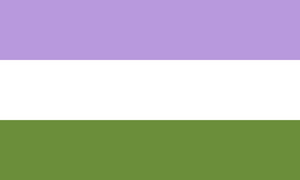
- genderqueer. An umbrella term covering non-normative gender identity and gender expression. Genderqueer can also be a specific identity.
- gender role. A society's norms for how to divide labor by gender.
- gender variant, gender variance. Gender expression that is different from Western cultural norms. Can mean gender non-conforming and/or transgender, as well as some non-Western gender roles.[41]
- genetic boy. A less correct term for an AMAB person, which see.
- genetic girl. A less correct term for an AFAB person, which see.
- gray-asexual, or grey-romantic. A romantic or sexual orientation that partly lacks attraction to people of any gender.[42]
- graygender, or greygender. Coined by Invernom. A non-binary gender identity that is between agender and some other gender, so that it is difficult to place, and not fully the absence or presence of a gender.[43] Compare demi-gender.
- gynephilic. A romantic or sexual orientation in which a person feels attraction to women or femininity.[44]
H
- hermaphrodite. An old word for a person with an intersex condition. Some see this word as offensive, and therefore only intersex people can reclaim this word. Non-intersex people shouldn't use this word.
- he-she or heshe. 1. An offensive word for a transgender woman. Only trans women can reclaim it. Other people shouldn't use it. 2. Several sets of pronouns use heshe in the nominative form.
- heteroromantic. A romantic orientation in which a person feels romantically attracted to people of a different gender than their own.[45]
- heterosexism. A sexist way of thought in which only heterosexuality is seen as normal, resulting in discrimination against people of other sexual orientations.[46]
- hir. Many sets of gender-neutral pronouns use this word in the accusative or possessive forms. Some such sets are heesh, hi, se, s/he, sie, and ze.
- homoromantic. A romantic orientation in which a person feels romantically attracted to people of the same gender as themself.[47]
I
- Ind. Coined by Torin Unrealisk in 2014.[48] A gender-neutral title, short for "individual."
- intergender. A certain nonbinary gender identity in between female and male. In the 1990s, this was an identity label that any person could use, even if they were born with non-intersex (dyadic) bodies,[49] but others say it should only be used by people who were born with intersex bodies.[50]
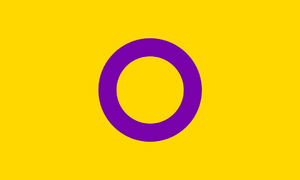
- intersex. 1. (obsolete) Homosexual.[51] 2. Intersex people have some aspect of their sex that is inconsistent with conventional ideas of male and female sex, in their primary or secondary sexual characteristics, hormones, or chromosomes.
- institutional oppression. "Arrangement of a society used to benefit one group at the expense of another through the use of language, media education, religion, economics, etc."[52]
- internalized oppression. "The process by which an oppressed person comes to believe, accept, or live out the inaccurate stereotypes and misinformation about their group."[53]
- inversion. An early clinical term for "gender identity and role disturbance." Early psychologists used the word "invert" for gay, lesbian, and transgender people, all alike.[54]
- invisible minority. "A group whose minority status is not always immediately visible, such as some disabled people and LGBTIQ people. This lack of visibility may make organizing for rights difficult."[55]
L
- lesbian. A person who identifies as a woman, who is romantically or sexually attracted only to women.
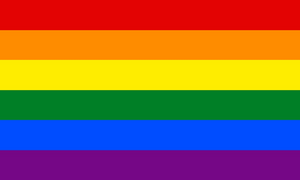
- LGBT. Lesbian, gay, bisexual, and transgender.
M
- MAAB. See GAAB.
- Gender binary#Male. Anyone with a male gender identity is male. Regardless of what gender he was assigned at birth, or what kind of body parts he has or wants to have, if he identifies as male, then he is a man or boy.
- male to female transsexual (MTF). A trans woman.
- maverique. A specific nonbinary gender identity "characterized by autonomy and inner conviction regarding a sense of self that is entirely independent of male/masculinity, female/femininity or anything which derives from the two while still being neither without gender nor of a neutral gender."[58]
- misgender. To address someone in a way that contradicts their gender identity. This can be accidental, but if intentional, it can be an example of discrimination against transgender people (cissexism).[59]
- MSM. Men who have sex with men. This term means that they don't necessarily identify as gay or bisexual.
- MT*. Male to unspecified transgender. This term includes all transgender people who were assigned male at birth.
- MTF. Male-to-female transsexual (or transgender). A trans woman.
- MTN. Male-to-neuter (or neutrois) transsexual (or transgender).
- multigender people have more than one gender identity, either at the same time, or sometimes changing between them.
- multiromantic. See polyromantic.
- Mx. Coined in 1982 or earlier.[60] Pronounced mux, mix, mixture, or mixter. A gender-neutral title.
N
- neutrois. Coined by a neutrois person named H. A. Burnham in 1995.[61] Having one non-binary gender identity that is neutral. Not female, not male, and not a mix. Some neutrois people are transsexual, experience gender dysphoria, and want to get a physical transition.[62]
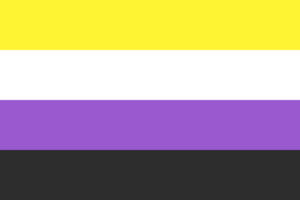
- non-binary gender or nonbinary gender. An umbrella term for all who don't identify as just female or male. Though there are many kinds of nonbinary gender identities, some people identify as "nonbinary" only.
- non-op. A trans person who hasn't gotten surgery, and won't get it.
- nounself pronouns. In 2014, a community of non-binary gender people on the social blogging site Tumblr.com came up with the idea of adapting any noun of one's choosing into a third-person pronoun, to create a wide variety of very personal and descriptive pronouns. The pronoun sets can be themed around concepts that have nothing to do with gender, such as nature, technology, or abstract concepts.
O
- orchiectomy. A kind of genital surgery.
- out. If someone is said to be out, that means they are open about their LGBT identity. If someone is said to have been outed, that means that their LGBT identity was made public by someone else, against their will.[63]
P
- packer. An artificial soft penis. Transgender people on the female-to-male spectrum wear these in their clothes as part of making a more male body shape.
- pangender. A non-binary gender identity that is made of a mix of all genders[64][65]. Or a fluid gender that could potentially be any gender. However, "all" and "any" don't include genders that belong only to certain cultures or ethnic groups to which the person isn't entitled.
- panromantic, pansexual, polyromantic, and polysexual. Romantic and sexual orientations in which a person feels romantic attraction to many or all genders.[66]
- passing. When a person is seen by others as other than the gender they were assigned at birth. Some transgender people dislike this word, saying it gives the idea that they are being dishonest, when they are trying to be seen as they really are.[67]
- polyamory. A long-term romantic/sexual relationship that can be between more than two people at the same time, all of whom consent to the arrangement.[68]
- polygender. A gender identity in which a person has more than one gender identity, at the same time, or a mix.[69][70]
- post-op. A trans person who has gotten surgery.
- person perceived as a man (PPM) and person perceived as a woman (PPW). Created by Rabbit KM in 2015. People perceived as men are usually seen and treated as men, but who don't identify as male. For example, masculine nonbinary people, and some trans women. Vice versa for people perceived as women. This term is useful for people who often get misgendered.[71]
- pre-op. A trans person who hasn't gotten surgery yet.
- presentation. "The totality of one’s appearance, including attire, voice, behavior, body language, etc."[72]
- pumping. A body modification to the phallus, common as part of the physical transition of trans people in the female-to-male spectrum.
Q
- queer. A reclaimed slur for the LGBT+ community, and an umbrella term for identities that are not heterosexual and/or not cisgender. Some people use this as the name for their nonbinary gender identity.
- questioning. A situation in which a person's gender identity and/or sexual orientation aren’t known to them yet, and they are still trying to figure out what they really are.
- QUILTBAG. Queer, undecided, intersex, lesbian, transgender, bisexual, asexual, gay.
S
- same-gender loving. A term that homosexual and bisexual people of color made for themselves.[73]
- secondary sex characteristics. "Physical characteristics that emerge with the onset of puberty, including but not limited to: facial and body hair growth, muscle development, voice changes, breast development, and the ability to reproduce."[74]
- sex reassignment surgery. "A term used by some medical professionals to refer to a group of surgical options that alter a person’s sex to match their sex identity."[75]
- she-male. An offensive word for a transgender woman. This word should be reclaimed only by trans women. Other people shouldn't use it.
- singular they. A gender-neutral pronoun that has been standard English for over a thousand years. During the last two centuries, grammarians dispute whether it is good grammar, or if a different word should be used as a gender-neutral pronoun instead.
- sissy. From "sister." An offensive word for a feminine boy. Also, a trans-feminine sexual identity.[76]
- SOFFA. Short for Significant Others, Friends, Family, and Allies. This means people who aren't LGBT, but who care about and help LGBT people.[77]
- SRS. Sex Reassignment Surgery.
- stealth. In the transgender community, this means that a transgender person is living so that other people see them as the gender they want to be, while keeping it a secret that they are transgender.[78] Transgender women and transgender can be closeted, out, or stealth. In a culture that doesn't recognize non-binary genders, it is impossible to be a stealth non-binary person, because that society has no non-binary role to enter. In that situation, the only two options are to be closeted (you make sure nobody knows you're nonbinary) or out (you make sure everybody knows you're nonbinary, which isn't stealth).
- stone. A certain queer sexual identity. Specific kinds include stone butch and stone femme. Some see these as non-binary genders.
- stud. "An African-American and/or Latina masculine lesbian."[79]
T
- T. In the transgender community, the hormone testosterone.
- TG. Short for transgender.
- third gender. In anthropology, an umbrella term for ethnic non-cisgender/non-heterosexual gender roles, which may be analagous to transgender and sometimes non-binary genders. Some consider this phrase offensive, and people should reclaim it only with caution.
- top surgery. In the transgender community, euphemism for any gender-validating surgery on a transgender person's breasts.
- tranny. An offensive word for a transgender woman. This word should be reclaimed only by trans women. Other people shouldn't use it.
- trans. Short for transgender or transsexual.
- transactivism. The movement for rights for transgender people.[80]
- Trans-Exclusionary Radical Feminists (TERFs). A movement of cisgender women who fight against transgender rights, because they believe that transgender people are dangerous.[81] They don't call themselves TERFs, but they do call themselves gender critical or gender abolitionists.
- trans feminine. A transgender person who transitions in a feminine direction, but who doesn't necessarily identify as female. They may have a non-binary gender identity.
- trans-feminism, or transfeminism. The creation of this word in the late 1990s is credited to Diana Courvant and Emi Koyama.[82] A feminist movement that takes into account transgender experience and rights.
- transgender. An umbrella term for those with gender identities that don't match the genders they were assigned at birth.
- transition. The process that individuals typically experiencing gender dysphoria go through to reach their desired social gender role, and/or physicality. There is no one definition of transition, as the term is based on the unique requirements of each individual.
- trans man. The correct term for a transgender person who has a male gender identity.
- trans masculine. A transgender person who transitions in a masculine direction, but who doesn't necessarily identify as male. They may have a non-binary gender identity.
- transsexual, or transexual. A kind of transgender person who wants to physically transition to a different gender than they were assigned at birth.
- TS. Short for transsexual.
- tucking. A method that a person can use to hide their penis and testicles, to create a more feminine or androgynous body shape.
- trans-misogyny. Discrimination and hate crimes against transgender women.
- transphobia. Discrimination and hate crimes against transgender people.
- transvestite. Coined by sexologist and openly gay man Magnus Hirschfeld in 1910.[83] A clinical word for a cross-dresser. Some see "transvestite" as an offensive word, so it should be reclaimed with caution. The meaning of this word has changed a lot since it was coined. Some early sources use this word for transgender and transsexual people: "As late as 1951 many clinicians still used the term 'transvestism' to identify patients with profound gender pathology who requested SRS (Hertz et al., 1961)."[84]
- trans woman. The correct term for a transgender person who has a female gender identity.
- tri-gender. Having three different gender identities, or a mix of them, or changing between them.[85]
- truscum. In the 2010s, a movement of transsexuals (mostly trans men) who argue that a person is only really trans if they meet the diagnostic criteria of gender dysphoria, because they see transsexuality as only a medical condition.[86] Truscum also believe that people with non-binary genders are pretenders who make true trans people look ridiculous. Because this is a reclaimed slur, people who aren't transgender shouldn't use this word, and should instead say "trans medicalist." Transgender people reacting to the truscum movement decided to call themselves "tucutes". Tucutes are opposed to dividing the transgender community into "true" and "fake" trans people.
- Two-spirit. Hundreds of Native American cultures have gender roles in addition to cisgender female and cisgender male. "Two-spirit" is the agreed-upon modern English umbrella term for these gender roles.
W
- womyn-born womyn. Some groups of cisgender women use this term for themselves to make clear that they are not transgender women, and hold a discriminatory attitude against transgender women.[87]
- WSW. Short for women who have sex with women. They may or may not identify as bisexual or lesbian.[88]
X
- xe. Several sets of gender-neutral pronouns use "xe" in the nominative form.
- xenogender. Coined by Baaphomett in 2014. "A gender that cannot be contained by human understandings of gender; more concerned with crafting other methods of gender categorization and hierarchy such as those relating to animals, plants, or other creatures/things."[89] An umbrella term for many nonbinary gender identities defined in reference to very different ideas than female or male.
Z
- ze. Several sets of gender-neutral pronouns use "ze" in the nominative form.
See also
External links
- Susan's Place Transgender Resources Wiki: Terms and definitions
- Gender Neutral Pronoun FAQ.
- Jillian Cottle, "Hallelujah, it's raining labels."
- Raphael Carter, "Angel's Dictionary."
References
- ↑ "Trans, genderqueer, and queer terms glossary." [1]
- ↑ Raphael Carter, "Angel's Dictionary." July 14, 1996. http://web.archive.org/web/19990427014012/www.chaparraltree.com/raq/angels.shtml
- ↑ Nat Titman, "The Necker Cube: Symbol for androgyny." June 25, 2011. Practical Androgyny. http://practicalandrogyny.com/2011/06/25/the-necker-cube-symbol-for-androgyny/
- ↑ http://queerascat.tumblr.com/post/94559591894/nbshadow-introducing-ambonec-an-for-short
- ↑ "Terms." Queer Querys (blog). http://queerquerys.tumblr.com/terms
- ↑ "Ambonec." Mogai-Archive (blog). http://mogai-archive.tumblr.com/post/91796206149/ambonec-an-for-short (dead link)
- ↑ "LGBTQ Terms." Neutrois.com. [2]
- ↑ http://aporagender.tumblr.com/post/88346079784/could-i-ask-the-etymology-of-the-prefix-apora
- ↑ http://aporagender.tumblr.com/aporagender
- ↑ http://aporagender.tumblr.com/aporagender
- ↑ Jillian Cottle, "Hallelujah, it's raining labels." [3]
- ↑ Schneider, M., et al. APA Task Force on Gender Identity, Gender Variance, and Intersex Conditions, 2008 http://www.apa.org/topics/sexuality/transgender.pdf (PDF)
- ↑ Raphael Carter, "Angel's Dictionary." 1996-07-14. [4]
- ↑ "Boi." Susan's Place Transgender Resource Wiki. [5]
- ↑ t. aaron hans. "Gender terms." 2000. [6]
- ↑ Julia Serano, "Whipping Girl FAQ on cissexual, cisgender, and cis privilege." 2009-05-14. [7]
- ↑ "LGBT resources: Definition of terms." [8]
- ↑ Jack Molay. "Transgender and transsexual glossary." January 25, 2010. [9]
- ↑ Jack Molay, "Crossdreaming described." August 3, 2014. [10]
- ↑ "LGBT resources: Definition of terms." [11]
- ↑ Savage. "Demigender definitions." Demigender safe space. http://demigenders.tumblr.com/post/102344212344/demigender-definitions
- ↑ http://asexualityorg.proboards.com/index.cgi?board=gender&action=print&thread=9 Definitions Master List
- ↑ Jillian Cottle, "Hallelujah, it's raining labels." [12]
- ↑ "Gender-neutral pronoun FAQ." [13]
- ↑ Jack Molay. "Transgender and transsexual glossary." January 25, 2010. [14]
- ↑ Askanonbinary. January 21, 2014. http://askanonbinary.tumblr.com/post/74102698117/okay-everyone-i-want-your-input-on-this-were
- ↑ vector (revolutionator). Untitled post. September 2013. http://revolutionator.tumblr.com/post/60853952929/i-wish-there-was-an-nb-equivalent-to-words-like
- ↑ http://genderqueeries.tumblr.com/titles
- ↑ "En femme." Susan's Place Transgender Resource Wiki. [15]
- ↑ "Eunuch." Susan's Place Transgender Resource Wiki." [16]
- ↑ Zander, "Coming of age." 2013-02-28. [17]
- ↑ "LGBTQ terms." Neutrois.com. [18]
- ↑ "Trans, genderqueer, and queer terms glossary." [19]
- ↑ "LGBT resources: Definition of terms." [20]
- ↑ http://mogai-archive.tumblr.com/post/92281884804/genderflux
- ↑ "LGBT resources: Definition of terms." [21]
- ↑ "LGBT resources: Definition of terms." [22]
- ↑ "LGBT resources: Definition of terms." [23]
- ↑ "Gender presentation." Susan's Place Transgender Resource Wiki. [24]
- ↑ http://genderqueerid.com/about-flag
- ↑ "Gender variance." [25]
- ↑ Jillian Cottle, "Hallelujah, it's raining labels." [26]
- ↑ Invernom, "Identifying as graygender." [27]
- ↑ "LGBTQ Terms." Neutrois.com. [28]
- ↑ Jillian Cottle, "Hallelujah, it's raining labels." [29]
- ↑ "LGBT resources: Definition of terms." [30]
- ↑ Jillian Cottle, "Hallelujah, it's raining labels." [31]
- ↑ Torin Unrealisk (minimalistfish), "Ind. as a gender neutral title." February 15, 2014. [32]
- ↑ Donna Lynn Matthews, “What is intergendered?” 1998-10. http://cydathria.com/ms_donna/intergen.html
- ↑ Aeshling. "Intergender." Mogai-Archive. http://mogai-archive.tumblr.com/post/92026280519/intergender
- ↑ Raphael Carter, "Angel's Dictionary." 1996-07-14. [33]
- ↑ "LGBT resources: Definition of terms." [34]
- ↑ "LGBT resources: Definition of terms." [35]
- ↑ Lothstein.
- ↑ "LGBT resources: Definition of terms." [36]
- ↑ queerascat June 15, 2014. http://queerascat.tumblr.com/post/88853893401/this-is-the-flag-that-ive-designed-for-maverique
- ↑ Vesper H. 2014. http://maveriques.tumblr.com/flag
- ↑ Vesper H. (queerascat). June 26, 2014. http://queerascat.tumblr.com/post/89448452041/maverique-definition-reworded-06-21-14-a
- ↑ "Misgender." Susan's Place Transgender Resource Wiki. [37]
- ↑ Nat Titman, "When was the Mx gender-inclusive title created?" August 28, 2014. [38]
- ↑ Axey, Qwill, Rave, and Luscious Daniel, eds. “FAQ.” Neutrois Outpost. Last updated 2000-11-23. Retrieved 2001-03-07. [39]
- ↑ "Define." Neutrois Nonsense. [40]
- ↑ "LGBTQI Terminology." [41]
- ↑ Cottle, "By the end of this post, ‘gender’ may not look like a real word anymore." [42]
- ↑ Jillian Cottle, "Hallelujah, it's raining labels." [43]
- ↑ Jillian Cottle, "Hallelujah, it's raining labels." [44]
- ↑ "Passing." [45]
- ↑ Jillian Cottle, "Hallelujah, it's raining labels." [46]
- ↑ Cottle, "By the end of this post, ‘gender’ may not look like a real word anymore." [47]
- ↑ Jillian Cottle, "Hallelujah, it's raining labels." [48]
- ↑ Rabbit KM (queercrip). "Terms we need: PPW/PPM (people perceived as women/men)." April 11, 2015. http://queercrip.tumblr.com/post/116160527412/terms-we-need-ppw-ppm-people-perceived-as
- ↑ "Gender terms." [49]
- ↑ "Gender terms." [50]
- ↑ "Gender terms." [51]
- ↑ "LGBT resources: Definition of terms." [52]
- ↑ "Sissy." Susan's Place Transgender Resource Wiki. [53]
- ↑ "Trans, genderqueer, and queer terms glossary." [54]
- ↑ "Passing." [55]
- ↑ "LGBTQI Terminology." [56]
- ↑ "LGBTQI Terminology." [57]
- ↑ WARNING: Contains unpleasant verbal content. https://www.newyorker.com/magazine/2014/08/04/woman-2
- ↑ Alissa Quart, Republic of Outsiders: The Power of Amateurs, Dreamers and Rebels. p. 36.
- ↑ Trans Health editors, “Timeline of gender identity research.” 2002-04-23. http://www.trans-health.com/2002/timeline-of-gender-identity-research/
- ↑ Lothstein, p. 55-56.
- ↑ Jillian Cottle, "Hallelujah, it's raining labels." [58]
- ↑ Jack Molay. "Transgender and transsexual glossary." January 25, 2010. [59]
- ↑ "Womyn-born womyn." [60]
- ↑ "LGBT Glossary." [61]
- ↑ "Masterpost of genders coined by Baaphomett." 2014. MOGAI Archive. [62]

